Sony SEL P 18-200mm f/3.5-6.3 OSS Lens Review
Sony SEL P 18-200mm f/3.5-6.3 OSS Performance
At 18mm, sharpness in the cetre of the frame is already outstanding at maximum aperture, with clarity towards the edges of the frame being good. Stopping down only improves sharpness towards the edges fo the frame ever so slightly, with similar performance being achieved between maximum aperture and f/5.6 for this focal length.With the lens zoomed to 70mm, sharpness in the centre at maximum aperture still approaches excellent levels and the clarity towards the edges is very good. Peak sharpness across the frame is achieved at f/8 at this focal length, where sharpness is excellent across the frame.
Normally with high zoom ratio lenses, this is a steep drop off in sharpness as you approach the telephoto setting. This lens still performs remarkably well for the kind of lens it is, with very good sharpness in the centre of the frame at maximum aperture at 200mm. Clarity towards the edges of the frame drops to fairly good levels, improving to good levels as the aperture is stopped down to f/11 at this focal length. Excellent sharpness is achieved in the centre of the frame at f/8.
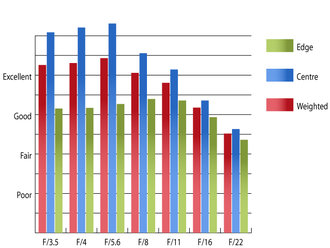 Resolution @ 18mm | 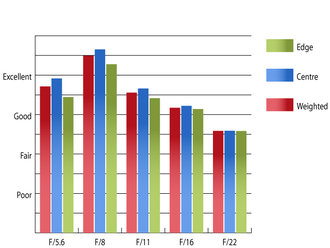 Resolution @ 70mm |
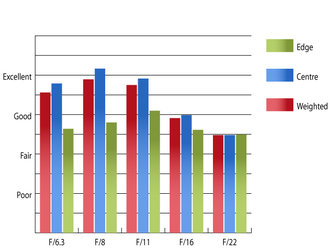 Resolution @ 200mm | How to read our chartsThe blue column represents readings from the centre of the picture frame at the various apertures and the green is from the edges. Averaging them out gives the red weighted column.The scale on the left side is an indication of actual image resolution. The taller the column, the better the lens performance. Simple. For this review, the lens was tested on a Sony NEX-5R using Imatest. |
Chromatic aberrations are pretty well controlled for the kind of lens this is, barely exceeding three quarters of a pixel width at 18mm, dropping to almost negligible levels in the middle of the zoom range and then rising again to levels that may become noticeable at 200mm towards the edges of the frame.
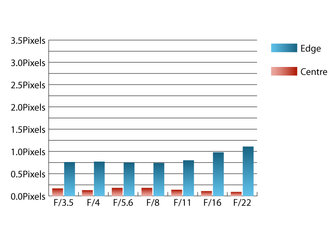 Chromatic aberration @ 18mm | 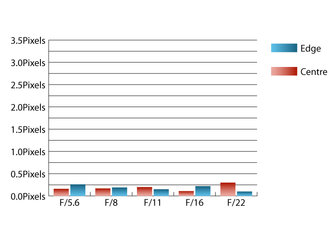 Chromatic aberration @ 70mm |
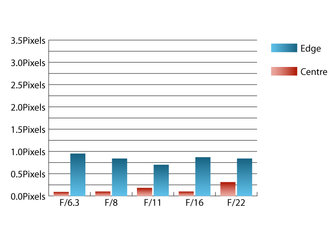 Chromatic aberration @ 200mm | How to read our chartsChromatic aberration is the lens' inability to focus on the sensor or film all colours of visible light at the same point. Severe chromatic aberration gives a noticeable fringing or a halo effect around sharp edges within the picture. It can be cured in software.Apochromatic lenses have special lens elements aspheric, extra-low dispersion etc. to minimize the problem, hence they usually cost more. For this review, the lens was tested on a Sony NEX-5R using Imatest. |
Falloff of illumination towards the corners of the frame is quite pronounced at 18mm as you may expect for a lens of this type. At f/3.5 and 18mm the corners of the frame are 1.75 stops darker than the image centre. As the lens is zoomed towards 200mm, falloff becomes less of an issue, with only very slight darkening of 0.399 stops in the corners at 200mm and f/6.3.
Imatest detected 4.01% barrel distortion at 18mm, which is enough to cause issues with images containing straight lines parallel to the edge of the frame. At 200mm this is replaced with 0.859% pincushion distortion, which is only a mild amount. Luckily the distortion pattern is uniform across the frame, which should make applying corrections in image editing software relatively straightforward.
The supplied lens hood does a reasonable job of shielding the lens from extraneous light that may cause issues with flare. Without the hood in place this lens is quite resistant to flare and retains good contrast, even when shooting into the light.
Add your message
Login required
Please login here or if you've not registered, you can register here. Registering is safe, quick and free.
Please login here or if you've not registered, you can register here. Registering is safe, quick and free.
photodo Stats
1102 lenses
428 MTF tests
74 in-depth photodo reviews
100+ users join each day
Help the lens community by reviewing or rating a lens today via our lens search
428 MTF tests
74 in-depth photodo reviews
100+ users join each day
Help the lens community by reviewing or rating a lens today via our lens search
Latest Lens Reviews
- Chinon 28mm f/2.8 Vintage Lens Review
- Canon EF 70-200mm f/4L IS II USM Lens Review
- Samyang AF 85mm f/1.4 EF Review
- Sigma 70mm f/2.8 DG Macro Art Review
- Samyang AF 24mm f/2.8 FE Review
- Meike 50mm f/1.7 Review
- Tamron 70-210mm f/4 Di VC USD Review
- Lensbaby Burnside 35mm f/2.8 Review
- Asahi Super Takumar 50mm f/1.4 Review
- Asahi Super-Multi-Coated Takumar 135mm f/3.5 Review
